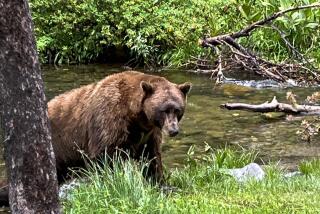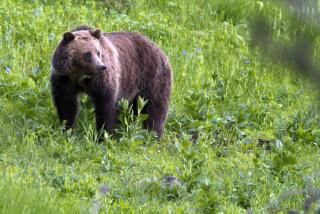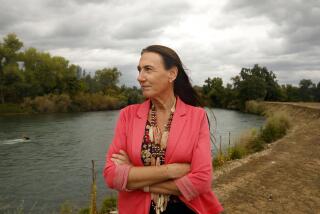No Proof Donner Clan Were Cannibals
SACRAMENTO — Nudging the history books, archeologists studying one of two campsites used by the ill-fated Donner Party during a snowbound Sierra winter 160 years ago announced Thursday that a study had unearthed no physical evidence of cannibalism.
The stranded emigrants settled into two camps during the harsh winter of 1846 and ‘47, and previous scientific studies confirmed cannibalism at the principal encampment, on the east shore of what is now Donner Lake.
The new findings do not conclusively prove that human flesh was ever consumed at the smaller camp -- where the families of George and Jacob Donner sought refuge -- but they do provide insights into their efforts to survive during four months beside Alder Creek.
“It’s possible no cannibalism took place at Alder Creek, and it’s also possible that proof simply can’t be found,” said Julie Schablitsky, a University of Oregon anthropologist. “No body doesn’t necessarily mean no crime.”
Cannibalism has long been the central focus of the Donner Party tragedy, which achieved mythic proportions as a tale of suffering and stoicism set in America’s westward expansion.
The wagon train of more than 80 emigrants was trapped in the teeth of the Sierra by winter, and half died amid starvation. Gory witness accounts by rescuers told of survivors resorting to eating human flesh.
The results from the archeological dig there cheered a modern descendant of the Donner family.
“It’s wonderful news,” said Lochie Paige, whose great-grandmother, Elitha Donner, made it out of the Sierra alive but saw the rest of her years shadowed by the tragedy.
“My dad always said she had not been any part of cannibalism. Now we have the scientific proof,” Paige said.
Schablitsky and her collaborator in the three-year study, anthropologist Kelly Dixon of the University of Montana, announced their findings during a 20-minute presentation at the Society for Historical Archeology conference here.
They formed a team of scientists in 2003 and applied the techniques of modern forensic crime examiners to look anew at one of the American West’s most enduring tales of tragedy.
They used DNA tests, electron microscopes and other modern research tools to analyze more than 16,000 bone fragments -- most measuring less than a half inch -- found in the principal cook fire used by the Donner family over four months.
But they discovered no human bones.
Instead, the Donner brothers, their families and several hired hands appear to have slowed the effects of starvation by consuming their cattle, horses, a pet dog and by bagging wild game, such as deer, rabbit and rodents.
“Their aversion to cannibalism is apparent,” Dixon said, noting the steps the family took to hunt food, slaughter their domestic animals and accounts by survivors and witnesses that they ate boiled rawhide and shoestrings.
Previous scientific studies at the lake camp confirmed cannibalism there by unearthing human bone fragments.
But Alder Creek, now a commemorative campground about three miles north of Truckee and bustling Interstate 80, has long been dogged by mystery and conflicting accounts about whether cannibalism really occurred there.
Several of the Donner family’s youngest members, who made it out alive, have long maintained that they managed to avoid cannibalism, and a young teamster -- one of the party’s hired hands -- who initially suggested flesh had been eaten later changed his story.
Given those discrepancies, Dixon and Schablitsky sought to confirm the truth.
They excavated the site during the summers of 2003 and 2004, finding the charcoal stain they conclude was the prime cook site at Alder Creek, where 22 pioneers began the winter. Eight of them died there.
The archeologists found scores of artifacts -- broken pieces of floral pattern cookware unique to the era, glassware, wagon hardware, steel oxen shoes and steel buttons.
Trapped, the pioneers also appeared to have attempted to create a semblance of normal life.
The anthropologists found pieces from a slate writing board they suspect may have been used to tutor the children, though microscopic examination could discern no writing.
Bone fragments had been burned and showed the signs of chop marks and “pot polish,” a microscopic sheen that appears as they tumble in the roiling waters of a cast-iron cook pot.
The Donners, the researchers said, were cracking bone to remove marrow and boiling the bone to extract remaining nutrients in a broth.
No DNA could be extracted, but analysis of the microscopic structure of the bone helped researchers determine the wide range of species the pioneers consumed to survive, Dixon said.
The absence of human bones does not mean the Donner clan did not resort at some point to cannibalism at Alder Creek in the last few weeks before the last survivors were rescued, Schablitsky said.
She said the most likely explanation for the absence of human bone is that flesh and organs might have been eaten, but the bodies were not hacked down to the bone.
After 160 years, she said, any unburned bone would have lacked the molecular integrity to survive decomposition in the acidic Sierra soil of the wet, pine-ringed meadow.
But if no cannibalism ever occurred there, what explains historical accounts by rescuers who reached Alder Creek in early March and reported seeing butchered bodies?
Schablitsky said the remains of those who died at the camp -- three teamsters; George Donner; Jacob Donner; his wife, Elizabeth; and their two toddler sons -- could have been torn apart by wild animals.
Even the freeze and thaw in the snowdrifts might have given them the appearance of being cannibalized, she said.
“They’re not medical examiners,” she said. “Would they be able to tell the difference between decomposing bodies and those that have been cannibalized?”
While the study has “illuminated the corners of the cannibalism question,” Dixon said, the elusive absence of an ironclad answer skirts a central focus of their research.
Their overriding mission is to revise the historical narrative, offering a fuller account of the daily travails the pioneer families endured during those awful four months in the snow -- and to offer some closure for modern-day ancestors who have always wondered.
“To have someone like Lochie Paige who is deeply affected by our archeology is quiet different for us,” Dixon said. “This is much more personal for all of us.”
More to Read
Sign up for Essential California
The most important California stories and recommendations in your inbox every morning.
You may occasionally receive promotional content from the Los Angeles Times.










